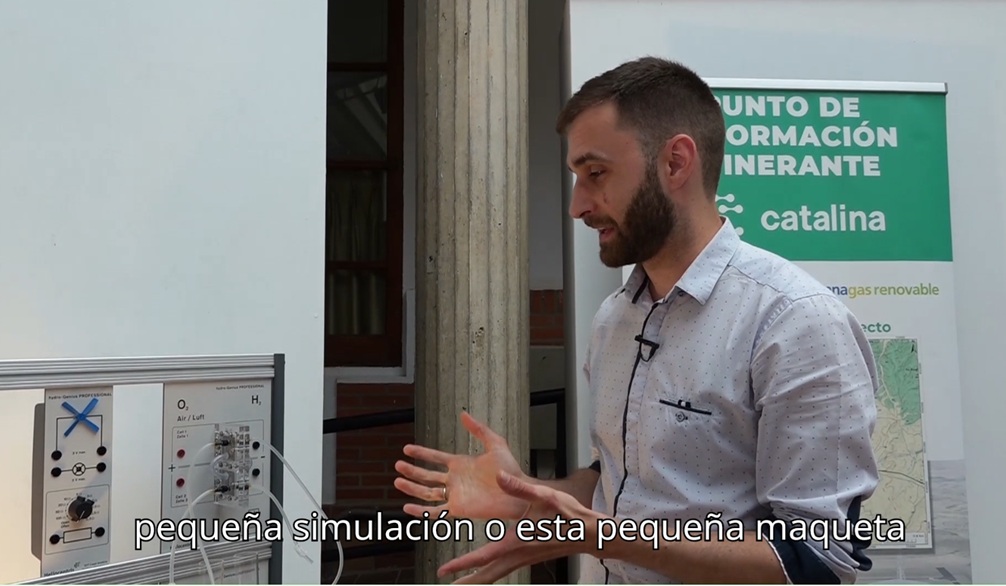From water to energy, and back: the green hydrogen cycle in the Catalina project
From Water to Energy, and Back: The Green Hydrogen Cycle in the Catalina Project
Green hydrogen in Aragon, within the context of the energy transition, positions itself as a key solution. Thanks to technologies like electrolysis, projects such as Catalina are driving a more sustainable energy model from the heart of Teruel.
In a world clamoring for sustainable energy solutions, Aragon Hydrogen Foundation (FHa) once again stands as a pioneer and disseminator. Recently, through an illuminating video, FHa has immersed us in the core of the ambitious Catalina project, set to come to fruition in Andorra (Teruel), reminding us why green hydrogen is much more than a promise: it is the key to our energy future.
The scene: a meeting point with tomorrow’s energy
Agile and direct, the footage introduces us to a mobile information point, a portal to the technological forefront of sustainable electrolysis, where the details of the Catalina initiative are showcased. But the true focus, capturing the viewer’s attention, is the voice of David Jiménez, Consulting Coordinator at Aragon Hydrogen Foundation, who, with impeccable teaching, breaks down the fundamental concepts of hydrogen, the most abundant element in the universe.
The essential element: unveiling the nature of green hydrogen in Aragon
“Hydrogen is a great element that can store a large amount of energy and be useful for integrating renewable energies into the electrical system,” explains Jiménez, placing the viewer before the current energy dilemma. He shows us how, at present, electricity generated by renewable sources is directly consumed. But what happens when the sun sets or the wind stops? That’s where the magic of hydrogen lies.
Modern alchemy: from water to the fuel of the future
A small model, a tangible simulation of the process, guides us through the virtual exhibition. A photovoltaic panel, with its “artificial sun” – a lamp that emulates our star – generates the primary electricity. This energy, which in the current model powers a small mill, is the same that, in the near future, will feed an electrolyzer. This small but powerful device is capable of dissociating the water molecule (H2O) into its essential components: oxygen and hydrogen. Jiménez emphasizes that this process, which requires electrical input from renewable sources, closes a virtuous circle: “We have taken electricity and water, and as a result, we have generated electricity and water again.” It is sustainability in its purest form.
The virtuous cycle: storage, transport, and return to the system
Beyond production, the narrative unfolds. Once obtained, green hydrogen in Aragon can be transported, stored – even in liquid state or injected into the gas grid, as proposed by the Catalina project – and, most fascinatingly, converted back into electricity through a fuel cell at the point of consumption. The byproduct of this reconversion is, again, water, consolidating a zero-emission cycle.
Catalina: beyond the project, a symbol for Aragon
The clarity of the explanation and the passion with which David Jiménez details each phase underscore Aragon Hydrogen Foundation’s commitment. Not only to the research and development of this disruptive technology, but also to public education and awareness.
Catalina project, with its industrial plant in Teruel, is not just an energy investment; it is a decisive commitment to positioning Aragon at the epicenter of the European hydrogen map, generating a socioeconomic and environmental impact that will resonate throughout the region.
More than an informative piece, the video from Aragon Hydrogen Foundation is more than just an informative piece; it is an invitation to understand, to participate, and to be an active part of an energy transition that is no longer a distant concept, but a tangible reality on the Aragonese horizon. The future is green, and hydrogen is its main vector.



